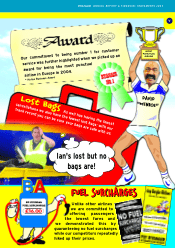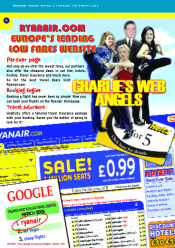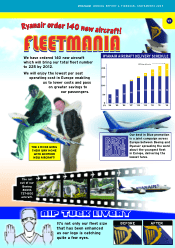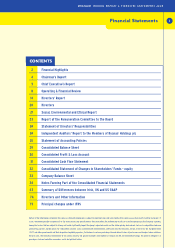Ryanair 2005 Annual Report Download - page 17
Download and view the complete annual report
Please find page 17 of the 2005 Ryanair annual report below. You can navigate through the pages in the report by either clicking on the pages listed below, or by using the keyword search tool below to find specific information within the annual report.
Irish Airports (continued)
The significance of this figure is that it will double the pre
Ryanair Shannon Airport traffic figure of just 2 million pa.
Competition works, and low cost efficient facilities at Shannon
are finally delivering rapid traffic and tourism growth for the
West of Ireland.
The contrast with the inefficient Dublin Airport monopoly could
not be greater. At Dublin Airport airport charges continue to
rise. The problems associated with badly designed and over-
specified facilities have adversely impacted not just airlines,
but passengers throughout the Summer. The passenger
experience at Dublin Airport is now much worse than any third
world airport. Expensive car parks, long queues, congestion,
inadequate seating and overcrowding prevail. Instead of
solving these problems by introducing competing terminals,
the Irish Government has awarded the contract for the second
terminal to the same inefficient monopoly that has completely
mismanaged the first terminal. We strongly believe that the
awarding of the second terminal - without tender or
competition - to the Government owned airport monopoly is
contrary to Irish competition, and EU public procurement
rules, and we have initiated legal proceedings to challenge this
decision in the Irish Courts. We are confident that when this
Government’s reported “secret deals” with the trade unions
are exposed, it will then be forced to allow competition and
introduce competing terminals to solve the shambles at Dublin
Airport.
Stansted Second Runway
The BAA monopoly continues to push ahead with its plan for a
£4bn second runway at Stansted Airport. Ryanair like all the
other airlines at Stansted is opposed to this grandiose waste
and profligate gold-plating. When a new runway can be built
for around £100m, and a terminal for between £250m to
£300m, it is hard to justify why the BAA wishes to spend 8
times this sum building facilities that its customers neither
want nor need. As usual with the BAA monopoly there is no
real consultation with airline customers, our views are
ignored, and the CAA which is supposed to regulate this
process stands idly by and allows the BAA to get away with it.
Unless this process is reversed Ryanair will resort to the
Courts to prevent the future of low cost air travel to/from
London being irreparably damaged by a high cost,
overspending airport monopoly which seeks to maximise
capital expenditure so that they can maximise their return.
The CAA has repeatedly failed to regulate this monopoly in the
interests of customers and users. We believe it is time that the
BAA monopoly was broken up and allow competition to
succeed where regulation has so blatantly failed. At a time
when airports all over Europe are developing efficient low cost
facilities, it is only the regulated monopolies at Stansted and
Dublin, which continue to plan expensive, inefficient facilities
under a failed and discredited regulatory regime. We regret
that the CAA continues to protect the BAA as it ignores the
input of airline users and seeks to increase costs for future
passengers at a time when those passengers are calling for
lower prices and more efficient facilities.
Current Trading
With oil at over $60 a barrel and the threat of further terrorist
attacks in London, it would be unwise to be anything other
than cautious in our outlook for the coming year. We have
recently announced strong first quarter results, where we
partially offset higher oil prices with slightly stronger fares
and other cost reductions. We expect this trend to continue,
particularly as we have hedged almost all of our fuel
requirements for the coming Winter at $49 a barrel. Other unit
costs will continue to fall by virtue of our new, lower cost,
aircraft deliveries combined with our low cost new destination
and airport base agreements. Any continuation of the recent
terrorist attacks in London could have a material impact on
bookings and yields through the Winter, but we remain hopeful
over the medium term that the growth in air travel will not be
damaged by these incidents. For our own part we look forward
over the coming year to retiring the last nine of our older
Boeing 737-200 fleet and becoming an all 737-800 fleet airline.
Operating a single type of aircraft will allow us to continue to
reduce operating costs, and it will enable us to maintain our
high technical dispatch reliability and excellent punctuality,
and at the same time enable Ryanair to operate the youngest
fleet in Europe.
Shareholders can rest assured that we will continue our
strategy of careful and disciplined growth, we will continue to
zealously tackle costs wherever possible. Above all we will
continue to reduce air fares in order to make air travel more
affordable for many millions of European consumers so that we
in turn can continue to deliver significant benefits to our
passengers, our people and our shareholders.
Yours sincerely,
Michael O’Leary
Chief Executive
(Continued)
Chief Executive’s Report 7
ANNUAL REPORT & FINANCIAL STATEMENTS 2005
























